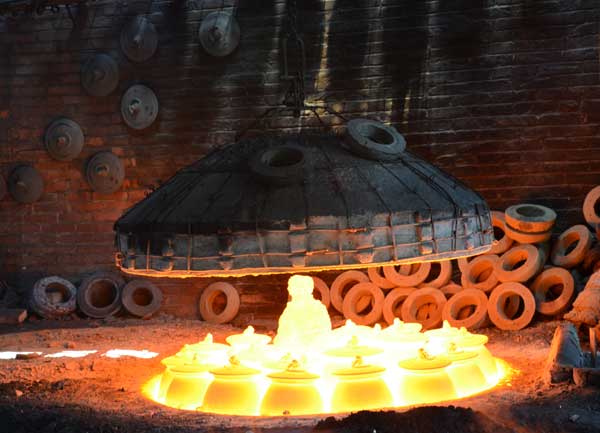

Pottery pieces are revealed after the 1,500 C firing process in a traditional kiln about 2 meters in diameter in Yingjing county, Sichuan province, on April 12. In the center is a new statue made by local potter Zeng Qinghong. Peng Chao / China Daily
Two dozen glowing pottery pieces revealed as a bowl-like structure is opened in a dim room. Zeng Qinghong gazes at a statue in the center of the pottery pieces, a smile on his face.
The statue is Zeng's latest artwork, just fired in a traditional kiln, about 2 meters in diameter, used to make black pottery in Yingjing county, Sichuan province.
With a history of more than 2,000 years of producing pottery, Yingjing county is as famous for its black pottery as the city of Yixing in Jiangsu province is for its purple clay pottery.
The pottery, which usually dries to a silver-gray, is made from a unique clay found in the county combined with local coal ash. The pieces are a muted black before being fired in 1,500-degree heat in the specially designed kiln, which is how they get their name.
Such black pottery is famous for its ability to keep food fresh.
Zeng, the eighth generation of potters to work in his family business, said he is finding ways to better carry forward the family craft, especially after a magnitude-7.0 earthquake in April 2013, whose epicenter in Lushan was only 40 kilometers away.
The quake cracked the walls of Zeng's factory and damaged more than a thousand pieces of pottery.
"I have changed my focus to making artworks instead of pots and teapots since the beginning of this year," Zeng said. His factory has 20 employees and produces about 100,000 pieces a year, most of them simple soup pots.
However, Zeng found that a piece of art could be worth thousands of yuan while a pot, though made from the same materials and using the same techniques, only sells for about 50 yuan ($8).
An art teacher from Beijing once came to Zeng's factory, and the two spent 20 days making a "Jiulong Pot", a pot with nine Chinese dragons pictured on its surface. A later visitor from Chengdu saw the pot and insisted on buying it.
"He threw me 10,000 yuan ($1,600) and ran away with it, but I dragged him back," Zeng said. He would not sell the pot, but the experience influenced him greatly.
"This may be a good way to help the pottery industry recover," Zeng said. The number of pottery factories has decreased to 36 from more than 100 before 2006, as many craftspeople closed their factories to work in big cities making a better income.
Zeng said other factories nearby have also begun to make artworks, and people are returning to the industry because they can now earn more money. New techniques are being applied to make pottery of different colors.
"It's a pity you can only make one artwork in a couple of days because it is much more complicated."
Zeng built a four-story building after the quake, and plans to turn it into a workshop and living place for artists.
"I will provide them with everything they need unconditionally as long as they come," Zeng said, adding that he wants nothing more than to help promote the development of black pottery.
Lan Jingsong, a 21-year-old local resident, has worked in the building for two month and made dozens of sculptures. He is a student of Tang Guofu, a master of arts and crafts in Sichuan province.
"I like making sculptures, and making them with such material is promising," Lan said.
Zeng also hopes to build an exhibition and experience park behind his factory.
"Young people should know about this primitive handicraft, which can barely be found in other parts of the country, or even the world," he said. Black pottery making was included in the list of national intangible cultural heritage items in 2008.
"I want to turn pottery making into an industry with cultural value, not just to make money. It has been a dream of mine since I was a little kid," Zeng said. He has been in the industry for more than 20 years, starting when he was only 14 years old.
There are some building materials on the open ground behind Zheng's factory, but his plan seems difficult to complete due to a lack of money.
"It may take 100 years," he said.
Copyright ©1999-2018
Chinanews.com. All rights reserved.
Reproduction in whole or in part without permission is prohibited.